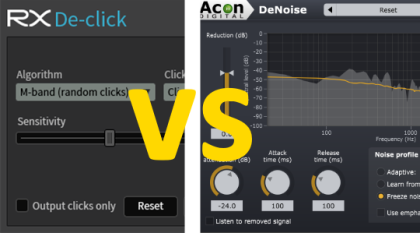iZotope vs Acon: A DIY audio repair shootout
iZotope must be feeling the heat! RX has some solid competition in the audio repair space coming from the talented coders at Acon Digital. Acon having set the price of their Resoration Suite at $99, may have been responsible for iZotope’s recent promotion of a new version of RX on sale at $99 (regular price $129).
 The RX Plug-in Pack has essentially the same feature set as Acon’s Restoration Suite. So these two products are perfect for a direct shootout. But, what would you really learn if I did the shootout? Not much. After all, I’m not recording in your space, with your mic, facing the issues that you face everyday.
The RX Plug-in Pack has essentially the same feature set as Acon’s Restoration Suite. So these two products are perfect for a direct shootout. But, what would you really learn if I did the shootout? Not much. After all, I’m not recording in your space, with your mic, facing the issues that you face everyday.
So, here’s how to do a shootout on your own…
Fortunately, both products offer free demo versions. The RX Plugin-Pack is fully functional for 10 days. And, The Restoration Suite’s demo adds a short period of silence at irregular intervals. Keep this in mind when comparing the results.
Now, here’s the fun part. You know how you go out of your way to make sure there are no interruptions when you record a session? Don’t do that.
Grab some copy, preferably something with a few plosives and some sibilant sounds. If you can’t find anything, try the theme song to Gilligan’s Island.
Before you record, you might want to forget to close the door all the way. Or turn on the dishwasher, or the air conditioner, or the — you get where I am going here.
You want a good read in a sloppy environment. Got it? Good.
Record it a second time, but get right up on your microphone and be a bit too loud — on purpose. This will make sense later.
Wait, you aren’t done recording yet. Go find a small fan, a hair dryer, a blender…
You’re looking for things in your environment that make droning noises when they are used. Set these things up so they can be heard inside your usual recording environment. Have a friend turn each thing on/off one at a time while you do another take.
If it’s trash day in your neighborhood or there is construction going on nearby, open the windows and record another take with those sounds as well.
Each of these interruptions has its own sonic signature. And, since no two recording setups are truly alike (believe me, even two identical professionally built booths in two different geographic locations will sound different), your studio will be unique in which frequencies it handles well and which ones seem to pass right through and wind up on the recording.
Now, save WAV files of these recordings being sure to name them so you know what they are:
- gilligan-dishwasher.wav
- gilligan-hairdryer.wav
- gilligan-garbage-pickup.wav
- gilligan-really-loud.wav
You get the idea…
Now, install both demos into the audio editor of your choice. No, really, right now, install them, I’ll wait…
Stop. This is the first test. And, it has nothing to do with the audio you recorded.
- How did the installation go?
- Was it easy?
- Was it straight forward?
- Was the documentation easy to find?
- Was it easy to understand?
Don’t skip this step. It’s more important than you think. If you’re having issues later on, this test is usually a pretty good indicator of how helpful the parent company will be when solving your issue.
Now, open each of the components in your audio editor of choice. Yes, right now, seriously, you know the drill…
- Did all of the components open without issue?
Some plugins expect certain features to be present, but some audio editors don’t implement all of these expected functions. If the components don’t work, it is more likely the fault of your chosen audio editor than the plugin. But, that’s another issue.
Now it’s time to get down to business. Open two copies of a single sound and play with one de-clicker, de-noiser, de-hummer, and de-clipper where you think they are needed.
Before you compare the results, I have a question for you.
- How easy was each component to use?
- Did you immediately understand everything or did it take a bit of poking around before the settings made sense?
Again, a well designed tool is usually a well supported tool. Assess both the interface and your experience using the tool.
Now, sit back and compare the results. And, get a friend to listen to the files as well and give you their opinion too. The more feedback, the better.
Wait, you aren’t done yet. Think of a simple question to ask both iZotope and Acon Digital. And, pose those questions via twitter. Links to their accounts are below:
By now, you know why I’m suggesting that you do this. A responsive company is usually a company that stands behind its products.
What were your thoughts? Results? Share them in the comments below.
☕ Cup of Coffee
A ridiculous amount of caffeine was consumed while researching.
Add some fuel if you would like to help keep me going!
☕ $5 ☕ $10 ☕ $15 ☕ $20 ☕ $25 ☕ $50
Related articles
- iZotope Announces New RX Plug-In Pack And Free Educational Resources
- Ask Slashdot: Linux and the Home Recording Studio?
- iZotope’s Dynamic Delay is free – and wonderful
- Don’t Buy New Recording Equipment. Do This Instead.
- Locke and Key the Audio Drama now Available on Audible
- Video: 24 and 32-bit Recording Formats Explained

